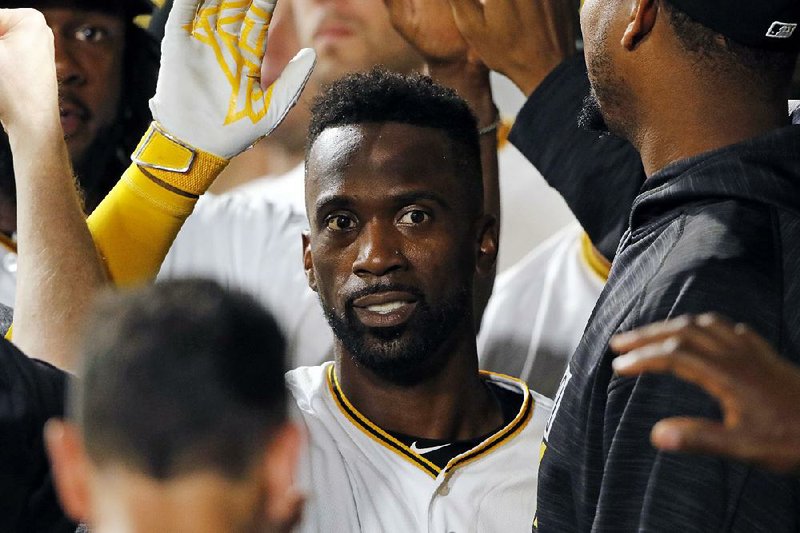ST. LOUIS -- Recently, two baseballs circulated the Pirates clubhouse.
They were procured by a pitcher and passed from player to player, each offering his opinion on whether the balls differed. One was from 2014, the year run production in the majors hit its lowest point since 1976. The other was from 2017.
Major League Baseball's popularity has rebounded in recent years, and so has the long ball. At the current rate of 1.27 home runs per game, the league's previous home run record -- set in 2000 at the peak of the steroid era -- will be broken in mid-September and shattered by season's end. The statistical spike has piqued curiosity across the clubhouse, and not only Pittsburgh's.
"Juiced," Andrew McCutchen said this week. "The balls are juiced."
McCutchen laughed. He was joking, for the most part. He thinks a number of factors have contributed to the power surge, but the juiced-ball theory is one he's heard often. The balls feel especially firm nowadays, McCutchen said, so it's possible the recipe changed.
"No one has come out and said it's scientifically proven that these balls are harder compared to years past. It's just a theory," McCutchen said.
He recalled in 2013, his MVP season, National League home run leaders Paul Goldschmidt and Pedro Alvarez had just 36. McCutchen plucked a bat from his locker and cracked a smile.
"I'm not complaining," he said. "I'm the one hitting."
The home run rise started in the second half of the 2015 season and has not slowed. The commissioner's office maintains the baseballs' specs have not changed, but an independent study published by Ben Lindbergh of the website The Ringer and sabermetrician Mitchel Lichtman showed post-August 2015 balls were bouncier -- having a higher coefficient of restitution -- and had lower seams and smaller circumferences.
A league spokesman said this week "all recent test results have been within the specifications," and said a third-party consultant determined there was "no evidence" the ball has had an impact on offense in recent years. Commissioner Rob Manfred told Yahoo Sports' Jeff Passan the notion he implemented a midseason ball swap "strains credulity."
If pitchers have noticed a difference, most publicly play coy.
"I can just give you a political answer," said Pittsburgh pitcher Gerrit Cole, his words tinged with sarcasm. "Yes, these balls are different because they have Rob Manfred's signature and not Bud Selig's."
Wade LeBlanc provides an interesting perspective. After spending parts of seven seasons in the majors, he played in Japan in 2015. There, players told him balls tended to change every year depending on run production the previous season. Change was the norm. Back in the majors in 2016, LeBlanc was stunned by the way balls flew off the bat.
"I started to notice baseballs going out like golf balls," he said. "Different flight paths. I didn't remember seeing those before I left. It's dangerous to assume things; it's an eye test thing."
The increase in home runs concerns pitchers because it eventually affects their paychecks. If warning track shots suddenly get legs and reach the second row, it's costly. LeBlanc insisted he didn't mind if the league had altered aspects of the game to boost offense and fan engagement. But in that case, he said, "figure out a different way to judge a pitcher, I guess."
"Regardless of what's happening -- baseballs, bats, stadiums or whether it's El Nino -- pitchers have to adjust," LeBlanc said. "Whatever is being changed or done, that's how it is."
Most explanations for the home run rate fail to pass muster. Pitchers' velocities continue to climb, but that's not new. There has been an infusion of power-hitting youths -- Aaron Judge, Cody Bellinger and Corey Seager, for example -- but even aging veterans Carlos Beltran, Adrian Beltre and David Ortiz saw their slugging numbers bounce back in 2015 and beyond. In the 2014-2016 seasons, the amount of players with 20-plus homers vaulted from 57 to 64 to 111.
A common conjecture centers on hitters' shifting approaches. On MLB Network last year, slugger Josh Donaldson said, "If you're 10 years old and your coach tells you to get on top of the ball, tell them, 'No.' Because in the big leagues these things they call ground balls are outs. They don't pay you for ground balls. They pay you for doubles, for homers."
Donaldson's comment was a red flag for pitchers.
"Everyone kind of laughed at it at the time," Pittsburgh reliever Tony Watson said. "But is he wrong?"
Hitters are increasingly aware of how sabermetrics align with their swings. In the Milwaukee Brewers' batting cage, screens show launch angle, exit velocity and a flight path of where the ball would have landed at Miller Park.
It also has become rare for players to employ two-strike approaches. Instead of compact swings, many sell out for the home run. Two-strike batting averages steadily decline, but there are more two-strike homers now than ever. In two-strike scenarios in 2014, hitters averaged a home run every 71 plate appearances. In 2017, it's one for every 52 plate appearances.
The strikeout rate has reached a new high each season since 2008. Pirates Manager Clint Hurdle said, "There's definitely a school of thought that a strikeout is no big deal anymore."
But if a boom-or-bust philosophy were prevalent, wouldn't one expect to see more fly balls? The current fly-ball rate is one point higher than in 2014 but lower than 2007-2011. The number of fly balls going for home runs, however, has increased by 44 percent since 2014.
"So, the fly-ball rate is not higher but they're going farther? Uh huh," mused Cole, who already has allowed a career-high 17 home runs this season, more than 32 percent of his career total.
He isn't alone. Clayton Kershaw has a 2.47 ERA but has given up a career-high 17 home runs.
"This is a massive shift in data," Cole said. "Guys are hitting fly balls at the same rate, and they're hitting home runs as if everybody is on juice."
He paused, searching for a solution.
"I've got to get the ball down," he said.
Sports on 06/28/2017


